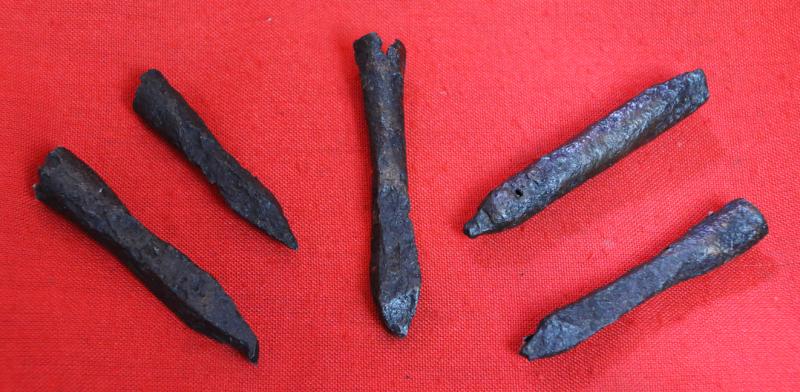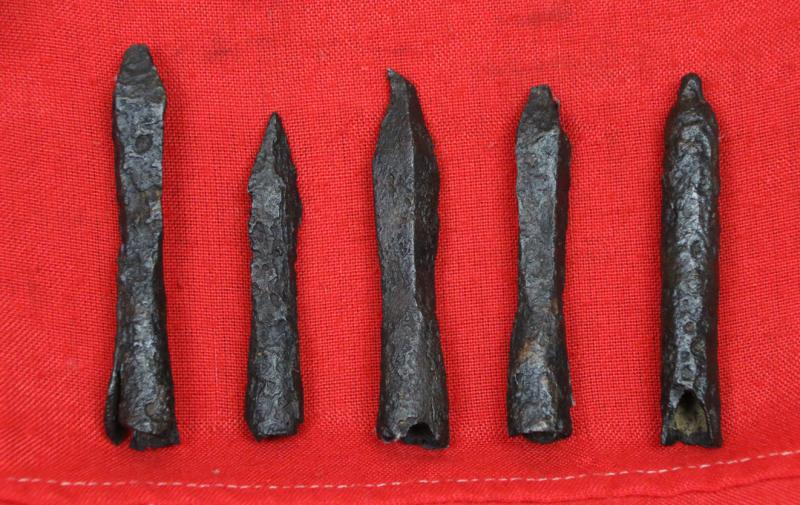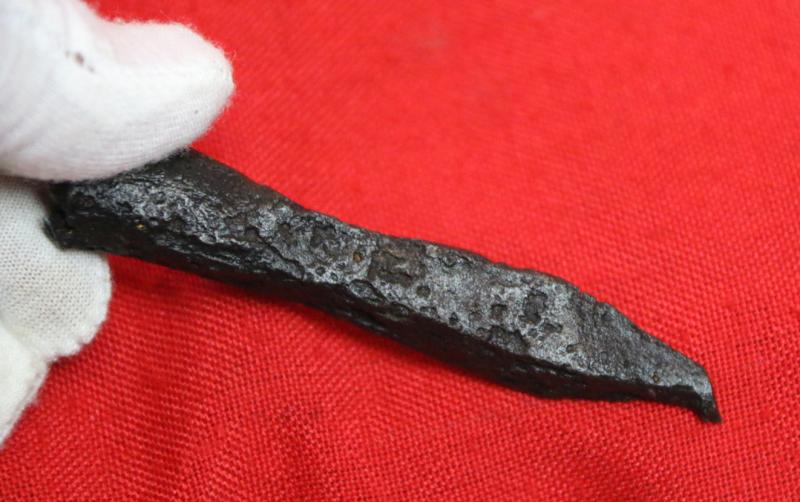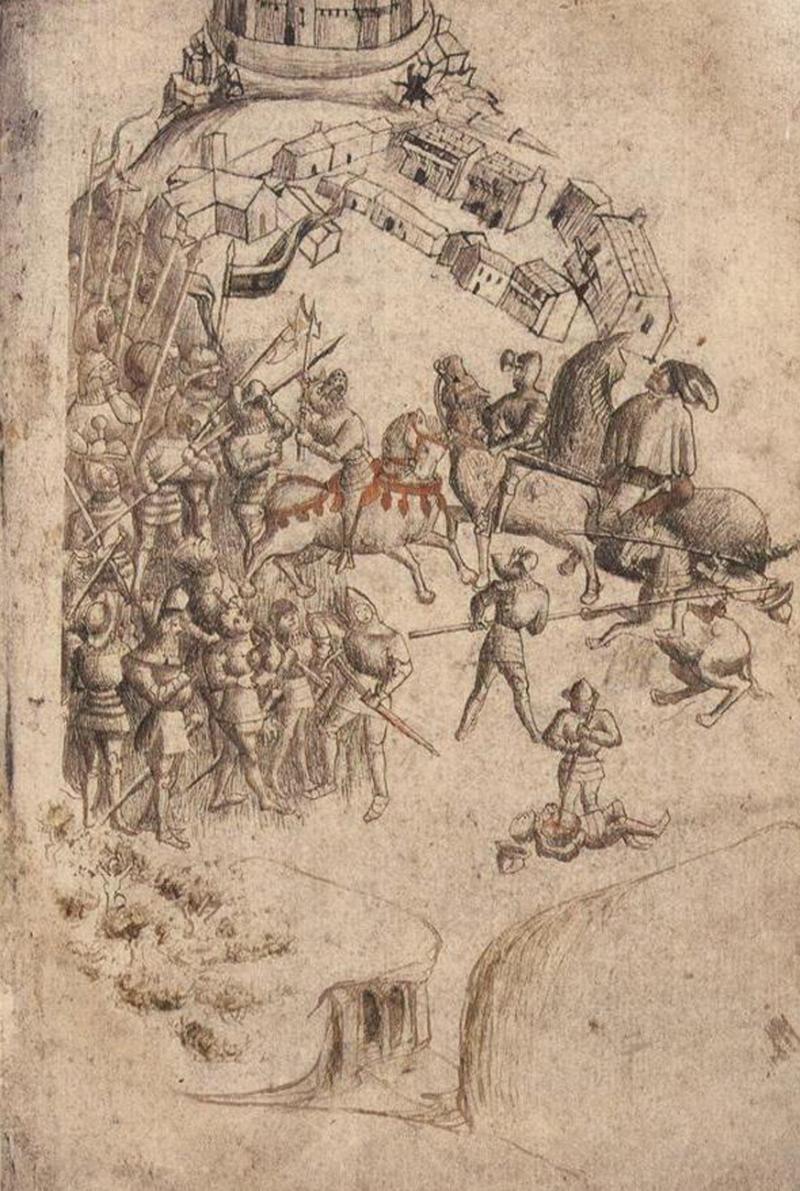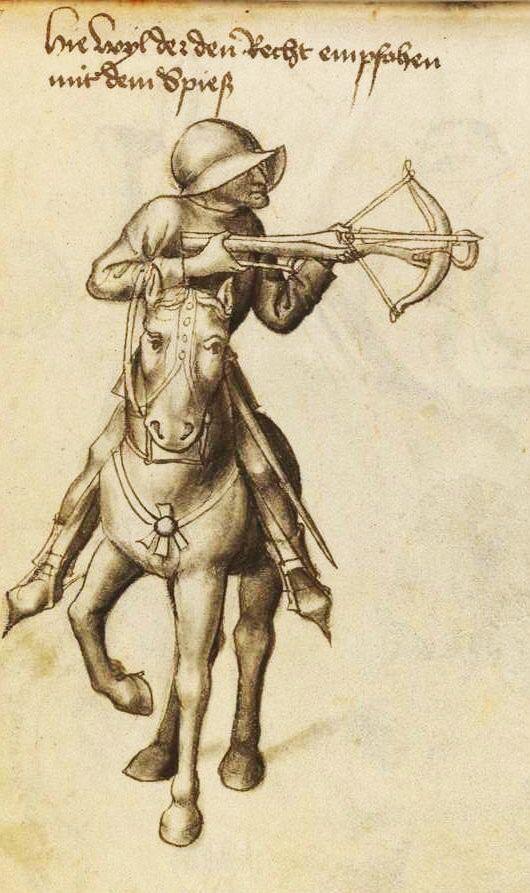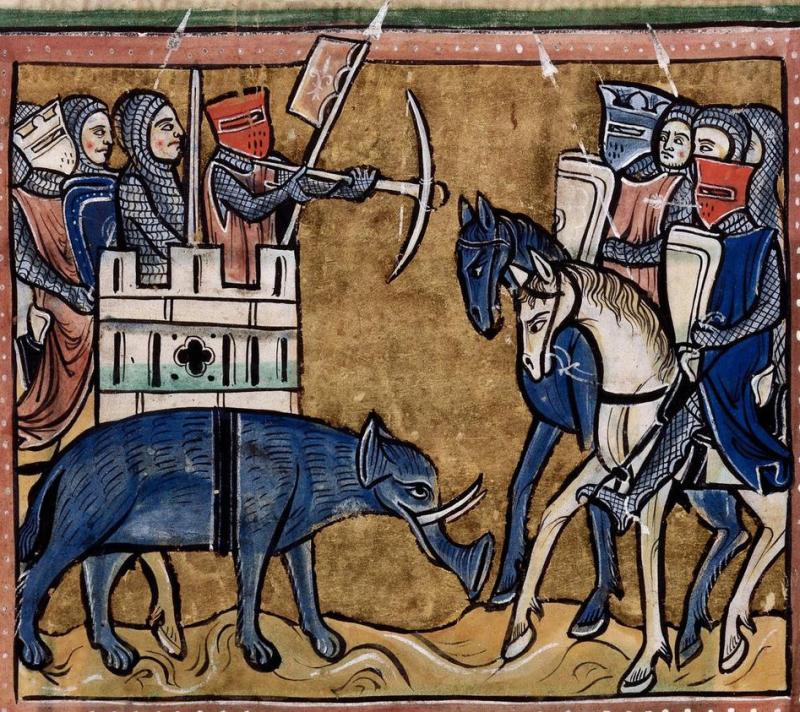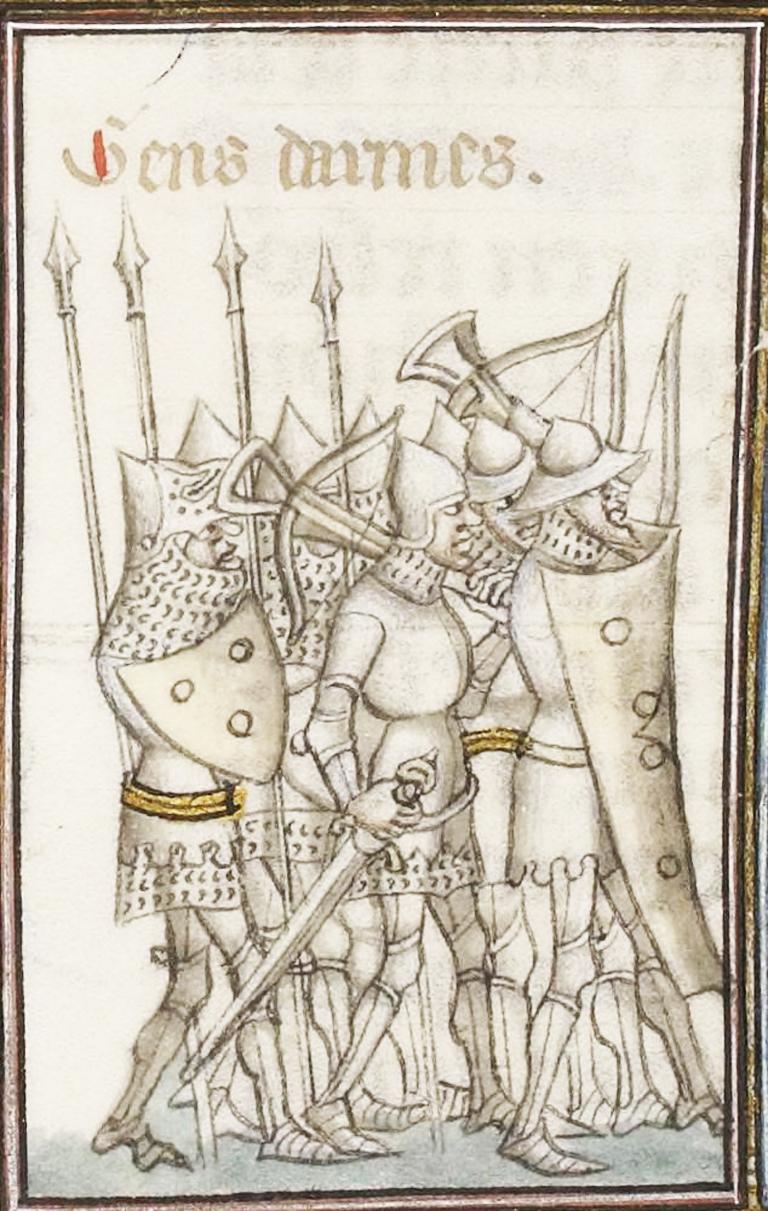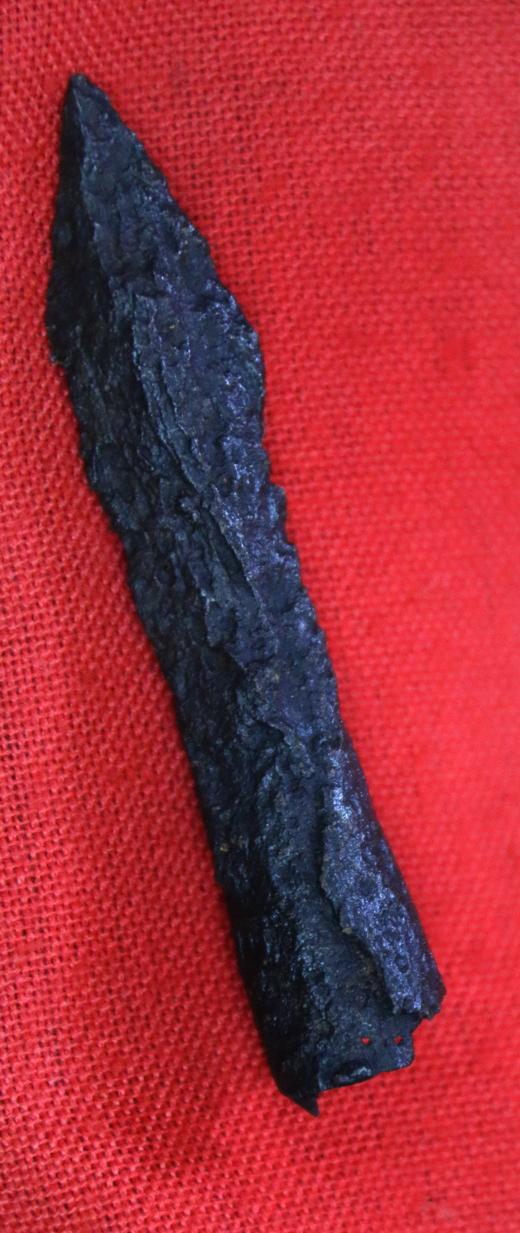Very Small Exclusive Collection of Amazing Crossbow Relics From the 1st Battle of Scottish Independence, The Battle of Bannockburn, in 1314, Crossbow Quarrel Heads. The Decisive Victory of Robert the Bruce In Combat Against King Edward II
For sale individually for 295 each. Recovered around 225 years ago, as a group of heads, covering about 2000 square yards, within in the battle site area, around one and a quarter miles south of Sterling. From the family of a renown 18th-19th century antiquity collector, a nobleman of Scotland. The crossbow was a weapon of both the Scots army and the British. Priced individually.
Overall the crossbowmen in the English army would have been equipped in quite a similar way to the longbowmen, apart from their choice of weapon.
The early fourteenth century was a time of great innovation in crossbow technology. Their stout bows were still being made out of wood, often the yew also used for longbows. However they were also increasingly made in a composite construction – strips of ibex or goat horn glued together formed the core, over which layers of frayed animal tendon were placed, and the whole wrapped in birch bark to seal out moisture. The most advanced bows, however, were made of tempered steel. This was a very new technology in 1314; the first documentary references to steel bows appear only around 1300.
The crossbow was a powerful weapon, with a much greater draw weight than the longbow. However the short bolts shot from the crossbow were also heavier, while the bolt’s acceleration time on the bowstring was much briefer; both of these factors meant that much more bow-strength was required to cast a crossbow bolt the same distance as a longbow arrow. The range and striking power of the crossbows at Bannockburn may not actually have been very different in real terms from those of the longbows deployed alongside them. The crossbow’s key advantage lay in the ease of its use. Only a short time was required to teach the operation of a crossbow, a stark contrast to the lifetime’s practice, beginning in childhood, which was essential for good longbow shooting.
The Battle of Bannockburn was fought on 23–24 June 1314, between the army of Robert the Bruce, King of Scots, and the army of King Edward II of England, during the First War of Scottish Independence. It was a decisive victory for Robert Bruce and formed a major turning point in the war, which ended 14 years later with the de jure restoration of Scottish independence under the Treaty of Edinburgh–Northampton. For this reason, the Battle of Bannockburn is widely considered a landmark moment in Scottish history.
King Edward II invaded Scotland after Bruce demanded in 1313 that all supporters, still loyal to ousted Scottish king John Balliol, acknowledge Bruce as their king or lose their lands. Stirling Castle, a Scots royal fortress occupied by the English, was under siege by the Scottish army. King Edward assembled a formidable force of soldiers to relieve it—the largest army ever to invade Scotland. The English summoned 25,000 infantry soldiers and 2,000 horses from England, Ireland and Wales against 6,000 Scottish soldiers, that Bruce had divided into three different contingents. Edward's attempt to raise the siege failed when he found his path blocked by a smaller army commanded by Bruce
The Scottish army was divided into four divisions of schiltrons commanded by Bruce, his brother Edward Bruce, his nephew, Thomas Randolph, the Earl of Moray and one jointly commanded by Sir James Douglas and the young Walter the Steward. Bruce's friend, Angus Og Macdonald, Lord of the Isles, brought thousands of Islesmen to Bannockburn, including galloglass warriors, and King Robert assigned them the place of honour at his side in his own schiltron with the men of Carrick and Argyll.
After Robert Bruce killed Sir Henry de Bohun on the first day of the battle, the English withdrew for the day. That night, Sir Alexander Seton, a Scottish noble serving in Edward's army, defected to the Scottish side and informed King Robert of the English camp's low morale, telling him they could win. Robert Bruce decided to launch a full-scale attack on the English forces the next day and to use his schiltrons as offensive units, as he had trained them. This was a strategy his predecessor William Wallace had not employed. The English army was defeated in a pitched battle which resulted in the deaths of several prominent commanders, including the Earl of Gloucester and Sir Robert Clifford, and capture of many others, including the Earl of Hereford.
The Two Days of the Battle;
An English army attempting to relieve the siege of Stirling Castle was defeated by a Scottish army under Robert the Bruce over two days.
Robert Bruce had been elected guardian of Scotland in 1298, replacing William Wallace as the leader of the long campaign against the English attempt to conquer Scotland. After the devastating defeat of Wallace at Falkirk (Falkirk, 1298) and then Bruce’s own defeat at Methven (Perth & Kinross, 1306), much of Bruce’s campaign took the form of guerrilla warfare, avoiding as far as possible major set piece battles. In this way he completely changed the balance of power in Scotland, through the progressive reduction of English garrisons.
By 1314 just two major strategic fortresses remained in English hands: that on the border at Berwick and that controlling the crossing of the Forth at Stirling. But the Stirling garrison finally agreed to surrender if the English king did not arrive with a relieving force by 24th June 1314. In response Edward II mustered an army of about 12-13,000 at Berwick, marching north in May and reaching Falkirk on the 22nd June.
Bruce deployed his forces in woodland south west of Stirling, through which the major road approached the town. He carefully prepared his chosen ground, beside the Bannock burn and, as the English advanced against him, over two days of fighting achieved a dramatic victory.
The action was fought, immediately to the north of the area where the Roman road crosses the Bannockburn around 1.2 miles to the south of Stirling. Day 2: Historic Environment Scotland places the fighting around the Carse of Stirling and the Dryfield, though five main alternative sites have been identified separated by more than 2 miles.
Every single item from The Lanes Armoury is accompanied by our unique Certificate of Authenticity. Part of our continued dedication to maintain the standards forged by us over the past 100 years of our family’s trading, as Britain’s oldest established, and favourite, armoury and gallery .
Pictures in the gallery of crossbowmen from original Medeavil manuscripts, {not included} and a contemporary battle scene drawn from the battle
Please note, *priced individually. The bent tipped quarrel head {photos 3 and 4} is now sold!
Code: 25735
295.00 GBP

